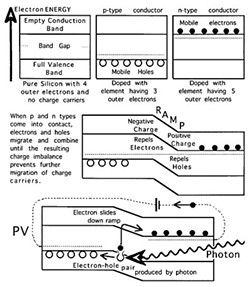[
{
"name": "Top Stories Video Pair",
"insertPoint": "7",
"component": "17087298",
"parentWrapperClass": "fdn-ads-inline-content-block",
"requiredCountToDisplay": "1"
}
]
Silicon, PhotoVoltaics and Light Emitting Diodes are of growing importance. Here’s how they work, using the analogy of a playground slide (or RAMP). Throw kids up onto it so they slide down, pile up at the bottom, and circuit around for a repeat. In photovoltaic cells, solar photons do the throwing and the kids are electrons. A light emitting diode is just the reverse: A battery shoves electrons up the ramp; they fall down and release energy in the form of photons.
The energy ramp results from joining differently doped pieces of silicon. Si atoms have four outer “valence” electrons which tightly bond with neighboring atoms. There are no loose electrons to conduct electricity, unless a photon kicks one up through the “band gap” into the “conduction band.” Si becomes a “p-type” conductor if doped with an element having only three outer electrons. The resulting electron vacancy or “hole” is mobile (watch a gap in a queue move backward as individuals step forward). Si becomes an “n-type” conductor if doped with an element having five outer electrons; the extra electron enters the conduction band.
When p-type and n-type materials come in contact, electrons and holes migrate by diffusion across the boundary. Electrons fall into the holes, and the boundary zone becomes depleted in both these charge carriers. The migration stops when the resulting charge imbalance causes a local electric field, my “energy ramp,” across the boundary zone.
In a PV device, a solar photon kicks an electron out of Si and up into the conduction band. That negatively charged electron slides down the energy ramp while the residual positively charged hole slides in the opposite direction. Electrons and holes move away from the junction and produce a current through an external circut. Simply reverse all arrows in my PV diagram and you have an LED.
Notes: The band gap for Si is about 1 volt. The dotted lines (Fermi levels) approximate the energies of conduction electrons in cold metals contacting the semiconductors.
I thank Lincoln Garlick for his advice.
more from the author
-
Nuclear Matters
- May 6, 2010
-
Sophie Smells a Shaker
- Feb 4, 2010
-
The Roots of Love
- Feb 5, 2009
- More »
































